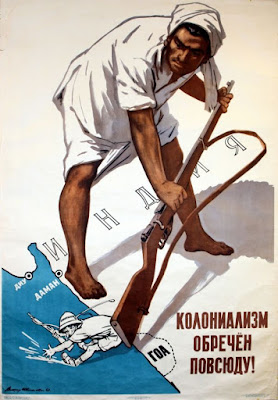The dream of Soviet Internationalism
 |
| Soviet Propaganda Poster c.1961 |
This blog will discuss the given
poster with reference to the memoir of Dada Amir Haider and Claude McKay and
expand on the ideas of dignity and third world liberation present therein. As
can be seen in either, the Soviet affinity to the third world and generally to the oppressed
people from across the world, as well as granting them the center stage, stands in
deep contrast to what the European logic of domination and difference had
previously been. McKay expressed his own experience in Soviet Union in the following words, "never in my life did I feel prouder of being an African, a black, and no mistake about it," and that perfectly sums up the newly found feeling of dignity and 'somebodyness' which Dada and McKay, as part of historically marginalized people, experienced for the first time in their lives in the Soviet Union.
This poster shows a larger than life
figure of a brown Indian peasant standing over India and casually throwing out a
Firangi soldier into the sea with the butt of his rifle. The
state of Goa is prominently marked to the bottom of the poster, since it was
there that resistance movement was taking shape against the Portuguese colonialists
in 1961. On the bottom left of the poster is written in Russian; ‘Colonialism
is doomed everywhere!’ The poster talks about the colonial question in the same
tone as that of Lenin when he announced to support freedom movements against
the colonialists across the world, or of Trotsky when he claimed, “The road to London
and Paris goes through Calcutta”. It is the peasant of the third world, the
layman, who embodies revolution or anti-colonial resistance for the soviet poster, and not a soldier or
a bureaucratic personnel. It is not the soviet soldier who goes into the war
zone and ‘liberates’ the people but the very own native people who own their freedom and its struggle. There is still a soldier in the poster, a Portuguese soldier,
who is trying to maintain his balance while being helplessly thrust out head-first of the Indian lands. Thus, systemic and monopolized forms of violence are framed as tools of the colonial forces which are bound to fail. The Indian peasants can be seen as dressed in
their traditional clothes. What binds them together is not a uniform but their passion for freedom and dignity which has long been denied to them.
The poster beckons the question,
how has the Indian peasant achieved an embodiment larger than that of the European?
Is it not that the very European logic of domination and difference which had
always posited themselves as superior to the Asian and African people and not the other way
round? The answer is that such poster was only possible in the soviet imagination, where the
freedom and rights of people, regardless of where in the world they are, were
more important than the historical power dynamics of colonialism which pinned
them down. It is the very idea which Dada Amir and Claude McKay talk about in
their memoirs, of dignity and recognition, things which were unimaginable in
the old world of European epistemic, racial and cognitive domination. The new world, lead on by the soviet imagination, was considerably different and more inclusive.
However, there must be a word of
caution before the blog concludes. In 1961, Indian army moved into the state of
Goa and threw out the Portuguese from there. USSR stood by the Indian state because of its alliance with Indian government which was there not because of some ideological affinity but rather of its pragmatic political interests. Was this the same as the image of a
peasant freeing himself and taking his destiny into his own
hands? One should be unwilling to accept such an idea, given the dynamics of post-colonial
India and the continued oppression of groups
such as the Adivasis who exist on the peripheries of social and political order. Propaganda may translate into a dream, as one can see in Dada Amir and Claude McKay's account, but it needs much more to be translated into reality.
Comments